Water, shade help prevent heat stress in cattle

COLUMBIA, Mo. — This is the time of year when cattle producers need to pay extra attention to heat stress in their operations, says University of Missouri Extension beef specialist Eric Bailey.
Unlike many other animals, cattle can’t rid their bodies of heat by sweating. Instead, they pant. Heat-stressed cattle show symptoms such as open-mouth breathing, slobbering and restlessness, Bailey says. Chronic heat stress leads to long-term problems such as decreased fertility and weight gain.
Breathing rate is a good indicator of heat stress in cattle, he says. Producers should be alert when respiration rates range from 90-110 breaths per minute. Rates of 110-130 breaths per minute indicate a dangerous level of stress. At 130 breaths per minute or above, producers should take emergency measures.
It is not just high daytime temperatures that create risks, Bailey adds. Overnight temperatures above 70 F create stress. Fermenting feed in the rumen also generates heat. Cattle can restrict critical airflow when they bunch up to reduce the amount of skin exposed to biting flies.
Producers should also keep humidity in mind when making decisions. Because of Missouri’s high humidity, heat stress can occur when temperatures reach the 80s.
In a press release, Bailey said, “The thermometer does not have to scream ‘Uncle’ at you before we have a severe heat stress event.” Cattle can adjust to elevated temperatures and humidity, but abrupt shifts in temperature and even seasonal changes can bring on heat stress.
It takes six hours for cattle to cool down after a heat stress heat event, he says. Cattle body temperatures peak two hours after peak daytime temperatures.
Less obvious reasons for heat stress occurring include changes in watering source or location, Bailey says.
Reducing heat stress
- Water. Allow 2-3 inches of linear head space for water. Bunk space for water is critical to preventing heat stress. Check water pressure to make sure tanks can keep full. This is especially important if cattle group together.
- Sprinklers. Use sprinklers to gently wet down animals. Avoid cold water shock. Do not mist the air to cool the animal; the mist will not get through the coat to reach the skin.
- Water source. Make sure the cattle are familiar with the type and location of the water source. Provide adequate water and space for cattle to drink.
- Shade. Bailey suggests looking online for shade structures to purchase or build yourself. You also can move animals to natural shade areas. Bailey recommends 20-40 square feet of shade per head. Shade cloth should be at least 8 feet off the ground for sufficient airflow. Orient shade either east-west or north-south. With an east-west orientation, the ground stays cooler but becomes muddy. North-south structures let shade move across the ground throughout the day.
- Cattle handling. Don’t work cattle during high temperatures. Work in early morning. Don’t let them stand more than 30 minutes in processing areas. Cattle in confined areas face more stress. Also, cattle eating tall fescue infected with toxic endophyte are particularly susceptible to heat stress during handling, says MU Extension forage specialist Craig Roberts. If it all possible, avoid handling cattle during periods of high temperature and humidity, Roberts says.
For more information:
Videos on many forage and livestock topics are available on the MU Extension Integrated Pest Management YouTube channel at youtube.com/c/MUIPM.
The MU Extension publication “Hot Weather Livestock Stress” (G2099) is available free online at extension.missouri.edu/g2099.
Miss Clipping Out Stories to Save for Later?
Click the Purchase Story button below to order a print of this story. We will print it for you on matte photo paper to keep forever.

